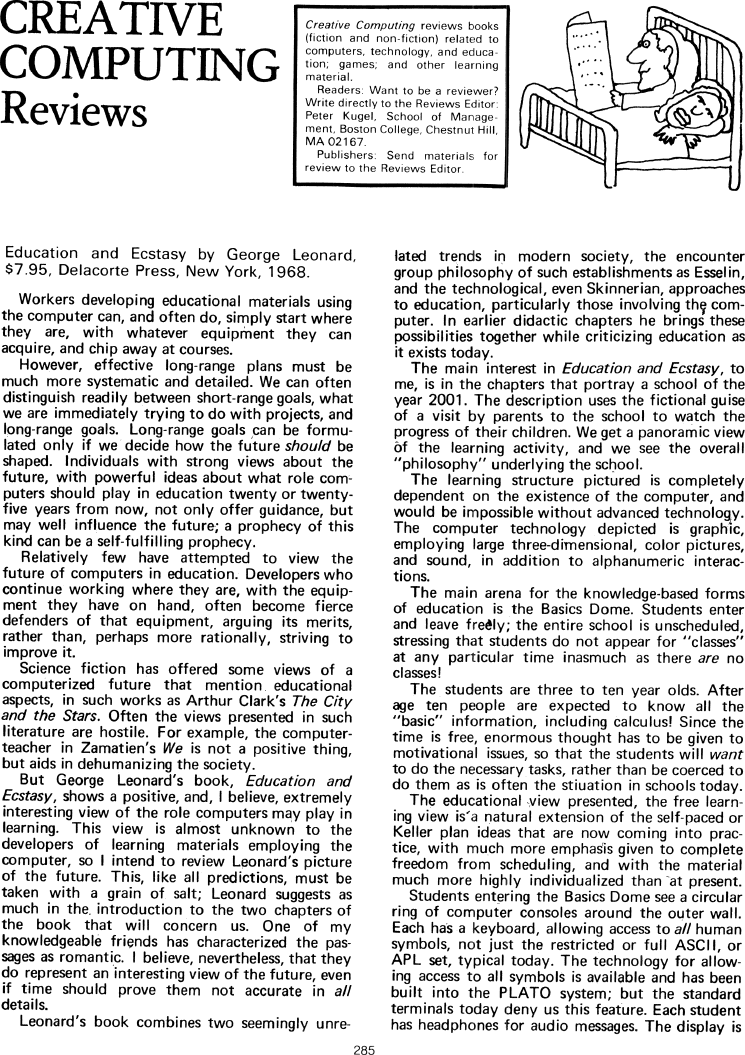The Best of Creative Computing Volume 1 (published 1976)
Education and Ecstasy (review, by George Leonard, 1968)

CREATIVE
COMPUTING
Reviews
Creative Computing reviews books (fiction and non-fiction) related to computers,
technology, and education; games; and other learning material.
Readers: Want to be a reviewer? Write directly to the Reviews Editor: Peter
Kugel, School of Management, Boston College, Chestnut Hill, MA 02167.
Publishers: Send materials for review to the Reviews Editor.
Education and Ecstasy by George Leonard, $7.95, Delacorte Press, New York, 1968.
Workers developing educational materials using the computer can, and often do,
simply start where they are, with whatever equipment they can acquire, and chip
away at courses.
However, effective long-range plans must be much more systematic and detailed.
We can often distinguish readily between short-range goals, what we are
immediately trying to do with projects, and long-range goals. Long-range goals
can be formulated only if we decide how the future should be shaped. Individuals
with strong views about the future, with powerful ideas about what role
computers should play in education twenty or twenty-five years from now, not
only offer guidance, but may well influence the future; a prophecy of this
kind can be a self-fulfilling prophecy.
Relatively few have attempted to view the future of computers in education.
Developers who continue working where they are, with the equipment they have on
hand, often become fierce defenders of that equipment, arguing its merits,
rather than, perhaps more rationally, striving to improve it.
Science fiction has offered some views of a computerized future that mention
educational aspects, in such works as Arthur Clark's The City and the Stars.
Often the views presented in such literature are hostile. For example, the
computer teacher in Zamatien's We is not a positive thing,
but aids in dehumanizing the society.
But George Leonard's book, Education and Ecstasy, shows a positive, and, I
believe, extremely interesting view of the role computers may play in learning.
This view is almost unknown to the developers of learning materials employing
the computer, so I intend to review Leonard's picture of the future. This, like
all predictions, must be taken with a grain of salt; Leonard suggests as much in
the introduction to the two chapters of the book that will concern us. One of my
knowledgeable friends has characterized the passages as romantic. I believe,
nevertheless, that they do represent an interesting view of the future, even if
time should prove them not accurate in all details.
Leonard's book combines two seemingly unrelated trends in modern society, the
encounter group philosophy of such establishments as Esselin, and the
technological, even Skinnerian, approaches to education, particularly those
involving the computer. In earlier didactic chapters he brings these
possibilities together while criticizing education as it exists today.
The main interest in Education and Ecstasy, to me, is in the chapters that
portray a school of the year 2001. The description uses the fictional guise of a
visit by parents to the school to watch the progress of their children. We get a
panoramic view of the learning activity, and we see the overall "philosophy"
underlying the school.
The learning structure pictured is completely dependent on the existence of the
computer, and would be impossible without advanced technology. The computer
technology depicted is graphic, employing large three-dimensional, color
pictures, and sound, in addition to alphanumeric interactions.
The main arena for the knowledge-based forms of education is the Basics Dome.
Students enter and leave freely; the entire school is unscheduled, stressing
that students do not appear for "classes" at any particular time inasmuch as
there are no classes!
The students are three to ten year olds. After age ten people are expected to
know all the "basic" information, including calculus! Since the time is free,
enormous thought has to be given to motivational issues, so that the students
will want to do the necessary tasks, rather than be coerced to do them as is
often the situation in schools today.
The educational view presented, the free learning view is a natural extension of
the self-paced or Keller plan ideas that are now coming into practice, with much
more emphasis given to complete freedom from scheduling, and with the material
much more highly individualized than at present.
Students entering the Basics Dome see a circular ring of computer consoles
around the outer wall. Each has a keyboard, allowing access to all human
symbols, not just the restricted or full ASCII, or APL set, typical today. The
technology for allowing access to all symbols is available and has been built
into the PLATO system; but the standard terminals today deny us this feature.
Each student has headphones for audio messages. The display is
285


